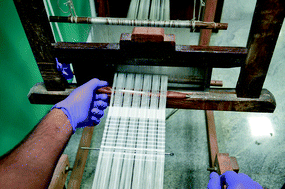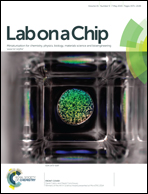Woven electrochemical fabric-based test sensors (WEFTS): a new class of multiplexed electrochemical sensors†
Abstract
We present textile weaving as a new technique for the manufacture of miniature electrochemical sensors with significant advantages over current fabrication techniques. Biocompatible silk yarn is used as the material for fabrication instead of plastics and ceramics used in commercial sensors. Silk yarns are coated with conducting inks and reagents before being handloom-woven as electrodes into patches of fabric to create arrays of sensors, which are then laminated, cut and packaged into individual sensors. Unlike the conventionally used screen-printing, which results in wastage of reagents, yarn coating uses only as much reagent and ink as required. Hydrophilic and hydrophobic yarns are used for patterning so that sample flow is restricted to a small area of the sensor. This simple fluidic control is achieved with readily available materials. We have fabricated and validated individual sensors for glucose and hemoglobin and a multiplexed sensor, which can detect both analytes. Chronoamperometry and differential pulse voltammetry (DPV) were used to detect glucose and hemoglobin, respectively. Industrial quantities of these sensors can be fabricated at distributed locations in the developing world using existing skills and manufacturing facilities. We believe such sensors could find applications in the emerging area of wearable sensors for chemical testing.


 Please wait while we load your content...
Please wait while we load your content...